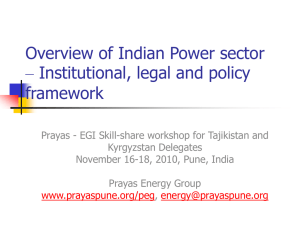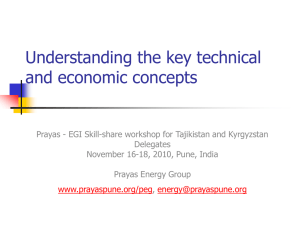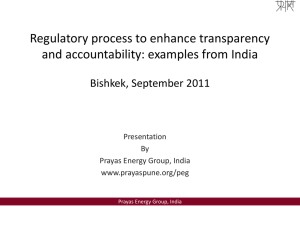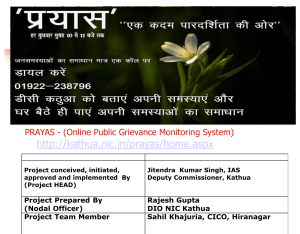Transition from MoU to Competitive Bidding
advertisement
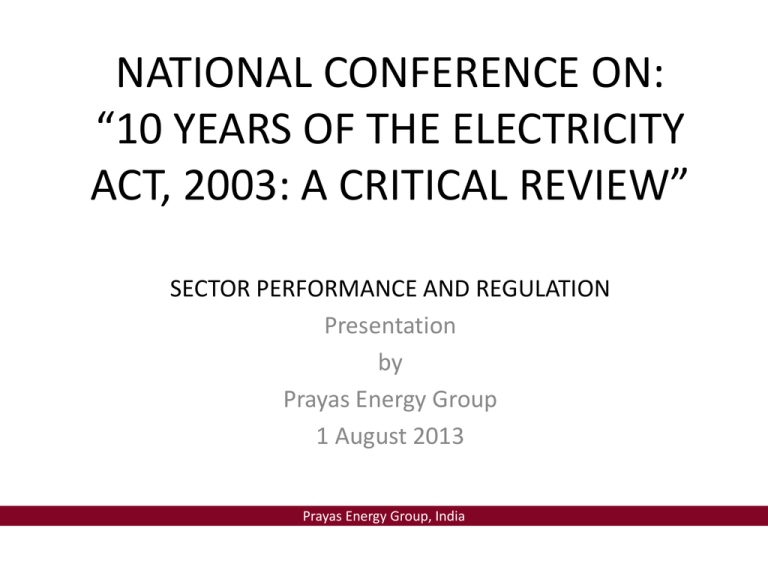
NATIONAL CONFERENCE ON: “10 YEARS OF THE ELECTRICITY ACT, 2003: A CRITICAL REVIEW” SECTOR PERFORMANCE AND REGULATION Presentation by Prayas Energy Group 1 August 2013 Prayas Energy Group, India Prayas - Energy Group Electricity Regulation Energy Efficiency Rural Energy Energy (Policy, Planning & Governance) Renewable Energy Climate Change Coal, Natural Gas Regulation Prayas Energy Group, India 2 Outline • Some of the key reform provisions in the Act – Ensuring electricity for all – Protecting consumer interest – Improving performance and encouraging efficiency • What have we achieved • Challenges and way forward Prayas Energy Group, India 3 Capacity Addition ICT applications Market operation The ‘happening sector’ Renewable • Political & Policy support • Massive investment • High interest of Indian and Transmission & Grid international players • Climate & fuel challenge End-use efficiency Distribution & Supply Rural electrification Prayas Energy Group, India 4 Electricity Act 2003: Reform agenda • Preamble: An Act…for taking measures conducive to: – protecting interest of consumers and supply of electricity to all areas, – rationalization of electricity tariff, promotion of efficient and environmentally benign policies, • Sec 6: Rural electrification: Joint responsibility of State & Central Government – Jointly endeavour to provide access to electricity to all areas including villages and hamlets through rural electricity infrastructure and electrification of households • Sec 61: Tariff regulations – Encourage competition, efficiency, economical use of the resources, good performance and optimum investments; – Safeguarding of consumers' interest and at the same time, recovery of the cost of electricity in a reasonable manner; rewarding efficiency in performance; • Sec 86. Functions of State Commission: – Ensure transparency while exercising its powers and discharging its functions. Prayas Energy Group, India 5 RGGVY: Major step forward • Commitment through National Electricity Policy 2005 – ensure minimum lifeline consumption 1 unit/household/day as a merit good by 2012 • Major GoI programme for rural grid extension – 90% capital subsidy, 10% loan from REC, Total investment of ~Rs. 90,000 Cr – Discom to ensure 6-8 hrs supply to newly connected HH • Status - time and cost overruns, quality concerns • Achievement: – 1.8 Cr HHs provided connection, Village electrification increased to 92% • Key challenge: – How to ensure adequate hours of supply on these rural feeders? Prayas Energy Group, India 6 Low levels of household electrification – nearly 8 crore households to be electrified Source: Census 2011 7 Uncomfortable truths • Slow progress of household electrification • Large proportion of APL households without access Village and Household Electrification Village Rural Household 100 BPL Non Electrified 21% % of villages/rural households 90 80 BPL Electrified 12% 70 60 APL NonElectrified 24% 50 40 30 APL Electrified 43% 20 10 0 1981 1991 2001 2011 Source: NSSO 2008-09 Prayas Energy Group, India 8 Poor are missing the electricity bus • 1 out of every 5 persons in world without electricity access lives in India • 45% of India’s rural households do not have access to electricity. • Electricity supply increased 75%, household access by 11% in last decade • Most consumers poor: those paying monthly bill > Rs 150: 45% of households • Anecdotal/typical data – – – – Average hours of supply in rural areas: 2-6 hours De-electrification of villages: 10% Un-authorised connections: 30% Permanent disconnections: 15-20% Prayas Energy Group, India 9 Structural disincentive to supply to rural households Marginal Power purchase cost in Rs/u PP cost after accounting for Dist loss of ~20% Distribution margin in Rs/u Total cost of supply in Rs/u Revenue from sale to electrified HH in Rs/u Loss per unit 3.5* 4.4 1.0 5.4 1.5 3.9 Needs increase in overall tariff *without accounting for the fact that this power will be required at peak hours and hence will be costlier Prayas Energy Group, India 10 Some action ideas • 100 x 100 connection drive – Offer connections to all within 100 meters of the power line, incentivise staff to meet connection targets – Recover the cost through ARR or State support • Transparency and accountability in Load shedding – SERC should decide Protocol through consultative process • Address structural dis-incentive for DISCOMs to supply to rural household – Make low cost power available and ensure zero load shedding in few select areas • Third party audits of DISCOM metering and billing – 80% of complaints to CGRFs on metering & billing – Underreporting of consumption of high end consumers and over-reporting of consumption of small consumers • Make grievance redressal mechanisms effective – Improve implementation through better DISCOM reporting formats, third party audit, raise compensation from employee – not ARR Prayas Energy Group, India 11 Institutional aspects • State Regulatory Commission key institution for ensuring transparency and protecting consumer interest – Viewed from limited mandate of increasing tariffs – Appointments is the most crucial issue • CGRF and Ombudsman responsible for grievance redressal – Not appointed in timely manner – Lack of support – Non-compliance of their orders • CEA: Collate and analyse key sector data and develop plans and report – more comprehensive status of generation capacity addition status – Need to focus on gathering more data from primary sources rather than relying on state utilities for information. Example, collating data from 11kV feeder meters to analyse actual hours of supply Prayas Energy Group, India 12 Regulatory Appointments • Till 2008, average duration for vacancies was 19 months for members and 7 months for a chairman • Post-2008, it is 8 months for members and 6 months for chairman. • Background of SERC Member and Chairpersons Trend in case of members Trend in case of Chairperson Prayas Energy Group, India 13 Public participation in regulatory processes • Only 4 commissions have appointed consumer representatives under section 94(3) – Only MH invites consumer representative for all proceedings • No funding to promote consumer participation – No institutional mechanism • More than half of the commissions do not have hearings in multiple locations for a single discom. – Large states like Rajasthan MP, Orissa, Karnataka and have hearings in a central location – 11 states have multiple discoms and only 7 have hearings in areas of licensee. • Only 7 SERCs publish regulations in a regional language and upload them on their website Prayas Energy Group, India 14 Listen to the poor: Bring their voice into regulatory forums • SERC to have Capacity building programs in line with National Electricity Policy and FOR reports • Officers to interact with small consumers and to identify, support pro-poor groups. • Public hearing on important issues at multiple locations. Separate public hearing on issues like load shedding, rural quality of service • All reports and material to be available in local languages and have audio-visuals • Consumer surveys with participation of consumer groups Prayas Energy Group, India 15 Ensuring efficiency in performance • Planning processes – – – – Most DISCOMs and SERCs do not undertake independent demand-supply assessment Lack of power purchase planning leading to high cost short term power purchase Large scale capex plans being approved but no post facto cost-benefit analysis No third party audit or verification of efficacy and prudence of capex undertaken • Metering and billing systems – 11 KV feeder data not available and/or reliable – No audit of IT systems used for billing – Division-level energy audit information is not available, many ERCs do not seek this data • Standards of performance – Compliance is still an issue, very few ERCs report this data in a useful manner – Reliability indices, no benchmarking Prayas Energy Group, India 16 Improving regulatory capacity to improve sector efficiency • SERCs can undertake independent studies for comprehensive demand assessment, load profiles – CEA can be a knowledge partner • Undertake public consultation on power purchase planning based on well studied comprehensive background/approach paper • Tariff regulations and MYT implementation needs to reviewed with a focus on efficiency improvement • Third party independent audit of Capex implementation and its cost-benefit analysis – Undertake public process to evaluate such assessments Prayas Energy Group, India 17 What should be done • DISCOMs, SERCs, FOR, Governments and Government agencies have roles • Efforts needed to regain credibility of regulatory institution • Ultimate aim should be to ensure good quality, affordable power supply to all people – Competition and financial viability is a means and not an end • Start by replicating ideas already implemented in some States • Relevant issues to be simultaneously taken up Prayas Energy Group, India 18 Thank you! Prayas Energy Group www.prayaspune.org/peg Prayas Energy Group, India 19

